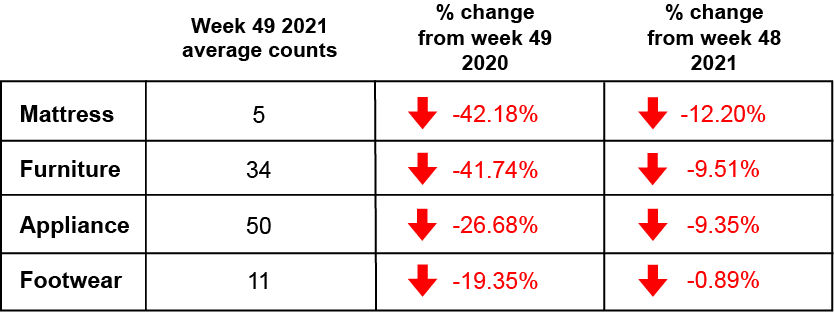Despite predictions from analysts, holiday sales rose 8.5% from November 1st to December 24th, with a majority of sales coming from physical stores.
Of the online sales, nearly 20-30% are expected to be returned before the end of the year.
This week we dive into how to make returns profitable and turn returns into returning customers.
THIS WEEK’S HIGHLIGHTS
- Holiday sales: A breakdown of online vs physical sales this holiday season.
- Making returns profitable: How returns turn into return customers.
- Furniture and the metaverse: How the metaverse could help furniture retailers show off their product.
FOOT TRAFFIC INDEX
Here’s a look at last week’s foot traffic compared to the same time last year.

FOOT TRAFFIC TRENDS
Industry insights so you can convert your foot traffic into more sales.
Holiday sales rise 9%
According to data from Mastercard, holiday sales rose 8.5% from November 1st to December 24th.
U.S e-commerce sales rose 11% in the same time frame, with physical stores seeing an 8.1% increase compared to the same time last year.
E-commerce accounted for 20.9% of all retail sales this year. With a majority of consumers concerned over shipping delays this year, many shoppers opted to buy online well in advance of the holidays.
Despite the predictions made by experts leading up to the holidays, sales during the holiday season blew past the expectations of many analysts.
Designing returns to be a strategy for growth
As we just learned, online sales accounted for 20.9% of all retail sales in 2021 and saw a growth of over 44% in 2020. But with more online sales comes more returns.
Nearly 20 to 30% of online sales are returned. Although online sales are not as prominent for big-ticket retailers, making returns a seamless process can be profitable for both e-commerce and brick-and-mortar retailers.
A former head at a big box retailer said “Customers who had a great seamless return experience would drive more sales than a customer who never had to return a product.” Essentially, returns can increase sales.
Personally, if I ever have a good return experience it does make me feel more comfortable shopping at that place again without the fear of buying something I can’t return.
The article goes on to explain that to enable growth, returns processes need to meet three targets: enhanced cost optimization, customer experience, and revenue preservation.
The metaverse and furniture industry
The technologies that make up the metaverse can include virtual reality—characterized by persistent virtual worlds that continue to exist even when you’re not playing—as well as augmented reality that combines aspects of the digital and physical worlds.
While it may sound a little outlandish, the metaverse could change how big-box retailers showcase their products. Some retailers have already started experimenting with digital showrooms, and the idea of the metaverse will only make digital showrooms more prominent.
Despite not being able to physically touch the furniture or test a mattress, using augmented reality, shoppers can see how the product will look in their own home and even see if it will fit in their space without measuring.
Click HERE to learn more about the possibilities of augmented reality in the furniture industry.
Retail Snippets
2021 In Review: A year for breakthrough ideas and commerce experiences.
Overlooked trends: The most overlooked retail trends of 2021.
First Look: Würth opens the first 24/7 store in Canada.
Boxing Day: UK retail foot traffic down 45% from 2019 Boxing Day.
RANDOM IRRELEVANCE
Jurassic Park: A perfectly preserved dinosaur embryo was preparing to hatch like a bird.
The Matrix: The robot workforce isn’t coming. It’s already here.
Spider-Man: ‘No Way Home’ becomes the first pandemic-era movie to smash the $1 billion milestone globally.
